
This section of the Rideau Canal Waterway website is devoted to the various memorial and markers that have been erected to commemorate those who helped to build the Rideau, including many of those who died during the construction of the canal. Definitive figures are not available, but a rough estimate is that about 1000 people died, the vast majority from various diseases, including about half that died from malaria (a temperate form of malaria endemic to warmer parts of Ontario at the time - it wasn't unique to the Rideau). For instance, in 1830, during the “sickly season” which spanned from August to mid-September, in the southern Rideau (from Newboro to Kingston Mills), the area hardest hit by malaria, there were up to 1327 men employed on the job in that section, of which 787 took sick with malaria. Deaths in that period were 27 men, 13 women and 15 children. Death from workplace accidents by contrast were quite low, for instance only seven workers died by accident in 1827.
The largest "ethnic" component of the workforce were immigrant Irish labourers, followed by the French Canadian labourers. These pick/shovel and axe workers numbered from about 1500 to 2500 per year. There was also a mixed group of skilled workers (Scottish and French Canadian stone masons, British carpenters and blacksmiths, coopers, stone-cutters, etc.), numbering about 500 per year. There were also the Royal Sappers and Miners (Scottish, British and Irish - skilled in stone-cutting, mining, smithing, carpentry and the like, numbering 162), the contractors and the Royal Engineers. In addition to the men, many women and children lived at the work sites, many of whom also died of malaria and other diseases of the day.
Some of these groups have been memorialized in one way or another as shown below. The listing has been arranged in geographic order - south to north.
| Celtic Cross - Kingston |
A Celtic cross in commemoration of the canal workers is located in Douglas R. Fluhrer Park in Kingston. It overlooks the foot of the Cataraqui River, the southernmost part of the Rideau Canal Waterway.
The cross was unveiled on November 23, 2002. The inscription on the cross states “In memory of an estimated one thousand Irish labourers and their co-workers who died of malaria and by accidents in terrible working conditions while building the Rideau Canal, 1826-1832.”
|
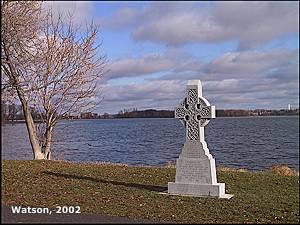
|
Rideau Canal & Workers Plaques - Kingston Mills
Two plaques at Kingston Mills commemorate those who constructed the canal. |
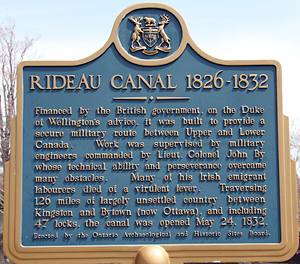
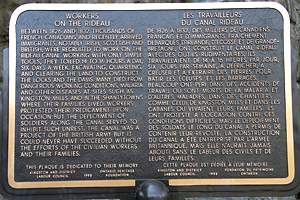
|
RIDEAU CANAL 1826-1832
Financed by the British government on the Duke of Wellington's advice, it was built to provide a secure military route between Upper and Lower Canada. Work was supervised by military engineers commanded by Lieut. Colonel John By whose technical ability and perseverance overcame many obstacles. Many of his Irish emigrant labourers died of a virulent fever. Traversing 126 miles of largely unsettled country between Kingston and Bytown (now Ottawa) and including 47 locks, the canal was opened May 24, 1832.
(Erected by the Ontario Archaeological and Historic Sites Board.)
WORKER ON THE RIDEAU
Between 1826 and 1832 thousands of French Canadians and recently arrived immigrants, notably Irish, Scottish and British, were recruited to work on the Rideau Canal. Working with only simple tools, they toiled 14 to 16 hours a day, six days a week, excavating, quarrying and clearing the land to construct the locks and the dams. Many died from dangerous working conditions, malaria and other diseases at sites such as Kingston Mills and in the shantytowns where their families lived. Workers protested their predicament upon occasion but the deployment of soldiers along the canal served to inhibit such unrest. The canal was a project of the British Army but it could never have succeeded without the efforts of the civilian workers and their families.
(This plaque is dedicated to their memory - Kingston and District Labour Council, Ontario Heritage Foundation, 1993.)
|
Colonel By - Jones Falls
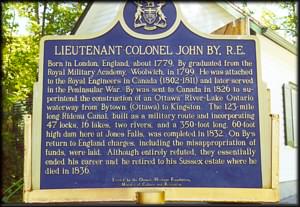 At Jones Falls there is an Ontario Heritage Foundation plaque erected in commemoration of Lt. Colonel John By (located at the visitor's information building near the lower locks). It states: At Jones Falls there is an Ontario Heritage Foundation plaque erected in commemoration of Lt. Colonel John By (located at the visitor's information building near the lower locks). It states:
LIEUTENANT-COLONEL JOHN BY, R.E.
Born in in London, England, about 1779, By graduated from the Royal Military Academy, Woolwich, in 1799. He was attached to the Royal Engineers in Canada (1802-1811) and later served in the Peninsular War. By was sent to Canada in 1826 to superintend the construction of an Ottawa River-Lake Ontario waterway from Bytown (Ottawa) to Kingston. The 123-mile long Rideau Canal, built as a military route and incorporating 47 locks, 16 lakes, two rivers, and a 350-foot long, 60-foot high dam here at Jones Falls, was completed in 1832. On By's return to England, charges, including the misappropriation of funds, were laid. Although entirely refuted, they essentially ended his career and he retired to his Sussex estate where he died in 1836.
|
Memory Wall - Chaffeys Locks
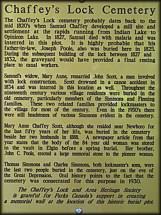 |
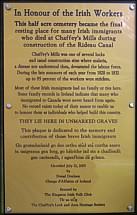 |
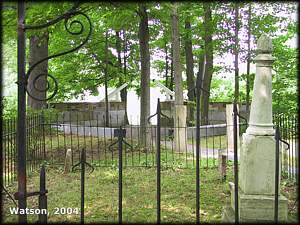
Memory Wall in background,
Chaffey family burial plot in foreground |
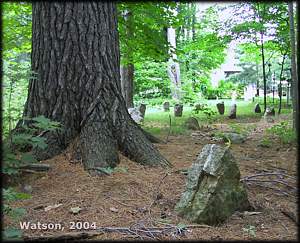
A Fieldstone marker sits beside a tree that has grown since the unknown person was buried. Restored section of cemetery in background. |
|
At Chaffeys Locks a large memorial known at the "Memory Wall" has been erected at one end of the Chaffey's Lock Cemetery (located adjacent to Brown's Marina). Plaques in memory of various local residents have been placed on these walls. This graveyard was used as a burying place for canal workers, their plots marked with field stones. It was also used as a burial ground for early local residents. Much of the cemetery has been restored in recent years by the Chaffey's Lock and Area Heritage Society. Two general plaques have been erected and read as follows:
Chaffey's Lock Cemetery
The Chaffey's Lock cemetery probably dates back to the mid 1820's when Samuel Chaffey developed a mill site and settlement at the rapids running from Indian Lake to Opinicon Lake. In 1827, Samuel died with malaria and was interred in ths plot. It is highly probably that his father-in-law, Joseph Poole, also was buried here in 1825. During the subsequent building of the lock between 1827 and 1832, the graveyard would have provided a final resting place to canal workers.
Samuel's widow, Mary Anne, remarried John Scott, a man involved with lock construction. Scott drowned in a canoe accident in 1834 and was interred in this location as well. Throughout the nineteenth century various village residents were buried in the old cemetery, particularly members of the Simmons and Fleming families. These two related families provided lockmasters to the village for most of the century. Even in the 1950's there were still headstones of various Simmons evident in the cemetery.
Mary Anne Chaffey Scott, although she resided near Newboro for the last fifty years of her life, was buried in the cemetery beside her two husbands in 1888. A newspaper article from that year states that the body of the 84 year old woman was stored in the vault in Elgin before a spring burial. Here brother, John C. Poole, erected a large memorial stone to the pioneer woman.
Thomas Simmons and Charles Simmons, both lockmaster's sons, were the last two people buried in the cemetery, just on the even of the Great Depression. Oral history points to the fact that the cemetery was consecrated for this purpose in 1930.
The Chaffey's Lock and Area Heritage Society is grateful for Parks Canada's support in creating a memorial wall at the location of this historic burial plot.
In Honour of the Irish Workers
This half acre cemetery became the final resting place for many Irish immigrants who died at Chaffey's Mills during the construction of the Rideau Canal.
Chaffey's Mills was one of several locks and canal construction sites where malaria, a disease not understood then, devastated the labour force. During the late summers of each year from 1828 to 1832 up to 95 percent of the workers were stricken.
Most of these Irish immigrants had no family or ties here. Some family records in Ireland indicate that many who immigrated to Canada were never heard from again. No record exists today of their names to enable us to honour them as individuals who helped build this country.
THEY LIE HERE IN UNMARKED GRAVES
This plaque is dedicated to the memory and contribution of those brave Irish immigrants.
Unveiled July 21, 2001 by Donal Denham, Charge d'Affaires of Ireland.
Erected by The Kingston Irish Folk Club.
|
Sappers and Miners - Newboro
Originally called the "The Military and Civilian Cemetery" then the "Old Presbyterian Cemetery" and then, in 2017, renamed as the "Royal Sappers and Miners Cemetery" this is the burial ground near Newboro for the canal workers that died during the construction of the Rideau Canal at the Isthmus (Newboro), including several (13) of the Sappers and Miners that were stationed at this spot. The cemetery saw continued use into the 20th century (last burials were in the 1940s). It is located on the north side of County Road 42, just to the west of the bridge crossing the Rideau Canal in Newboro.
While the name and heritage marker commemorates the Royal Sappers and Miners there were also canal era civilians (men, women and children) who died on-site during the building the canal and are buried in this cemetery, so the original name, the Military and Civilian Cemetery, is more accurate than Royal Sappers and Miners cemetery.
The Royal Sappers and Miners
In 1827 the Royal Sappers and Miners, the special construction corps of the British Army, raised the 7th and 15th Companies to serve in the building of the Rideau Canal. Comprising 160 skilled craftsmen and labourers under Royal Engineers, the companies arrived that year in Bytown, where they built military structures and locks. The 7th Company was transferred in 1829 to assist in the completion of the canal here at the Isthmus, the only section beyond Bytown built under direct military supervision. Sappers and Miners from both companies executed other major projects, including a dam at the Hog's Back, and performed guard-duty at various locks. In 1831 seventy-one were discharged in Canada and several settled along the canal as lockmasters.
Royal Sappers and Miners Headstone
Dedicated to the members of the 7th Company Royal Sappers and Miners laid to rest while serving the British Empire during the construction of the Rideau Canal at the Isthmus 1829-31.
John Bott, Charles Brown, Kenneth Cameron, Cornelius Connor*, Mashall Darling, Simon Gibson, John Higford, William Holden, Leonard Jasper, William Myles, Nathan Shaw, James Simmons, Joseph Stuart.
* A bit of doubt about Cornelius Connor since while one record indicates he died on December 13, 1831, other records show him as being discharged with other Sappers and Miners on December 24, 1831 (presumably alive).
|
Canal Workers - McGuigan Cemetery, Merrickville
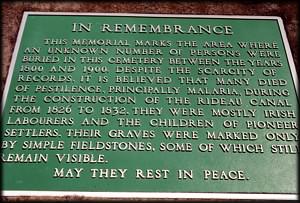 |
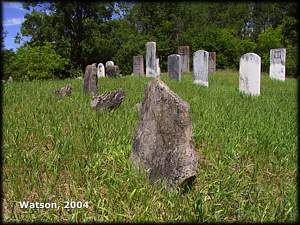
Field stones (foreground) mark grave sites,
possibly those of canal workers
|
This cemetery, restored by the Merrickville and District Historical Society, is located at 448 River Road, directly across the river from Clowes Lock, about 0.8 km south on River Road from Upper Nicholsons lockstation. The earliest known grave is that of Samuel McCrea who died on November 15, 1806. The cemetery operated until about 1892. There are two bronze plaques in the cemetery which read as follows:
McGUIGAN CEMETERY
This cemetery is one of the oldest burying grounds not only along the Rideau River but in Eastern Ontario. It was used for approximately one hundred years between 1800 and 1900. Unfortunately, there are few written records anywhere either as to its existence or as to who was buried within its confines. The tombstones discovered during its restoration in 1979 and 1980 by the Merrickville and District Historical Society tell only a small part of the role it played in the history of the area.
It was named after Miles McGuigan, an Irishman who served in the Peninsular War under Wellington in the 81st Regiment and who was later wounded at Waterloo. As an army pensioner after the War of 1812 he married the widow Leahy, who owned the land, a Crown Grant, on which the cemetery is located. Legend has it that he was buried here but his grave has never been found. The oldest known grave is that of Samuel McRae, one of the earliest pioneers of the Lower Rideau Settlement.
IN REMEMBRANCE
This memorial marks the area where an unknown number of persons were buried in this cemetery between the years 1800 and 1900. Despite the scarcity of records, it is believed that many died of pestilence, principally malaria, during the construction of the Rideau Canal. From 1826 to 1832, they were mostly Irish labourers and the children of pioneer settlers. Their graves were marked only by simple fieldstones, some of which remain visible.
May They Rest In Peace.
|
Colonel By - Ottawa
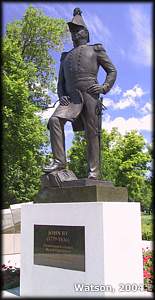 A statue to Lieutenant-Colonel John By stands in the poorly named Majors Hill Park which overlooks the spectacular flight of eight locks in Ottawa. The park got its name from Major Daniel Bolton who took over as Superintending Engineer of the canal after Colonel By was recalled to England to answer to (unfounded) charges of mismanagement of construction funding. However the whole affair put a black mark on Colonel By's reputation and it took over a century to start fully restoring Lt-Colonel John By's reputation and recognizing the significant role he played in the development of early Canada, including the founding of our nation's capital, Ottawa (formerly named Bytown). A statue to Lieutenant-Colonel John By stands in the poorly named Majors Hill Park which overlooks the spectacular flight of eight locks in Ottawa. The park got its name from Major Daniel Bolton who took over as Superintending Engineer of the canal after Colonel By was recalled to England to answer to (unfounded) charges of mismanagement of construction funding. However the whole affair put a black mark on Colonel By's reputation and it took over a century to start fully restoring Lt-Colonel John By's reputation and recognizing the significant role he played in the development of early Canada, including the founding of our nation's capital, Ottawa (formerly named Bytown).
The statue, created by scultor Emile Brunét, was unveiled on August 14, 1971. The statue was described as "It is a very moving statue. In the quiet of the evening one can almost feel the presence of this man standing, as he must so often have done, just a few steps from his verandah and gazing out across the head of the canal" (P.A. Camp in Royal Engineers Journal).
Also in Majors Hill Park are the foundations of Colonel By's house, which was destroyed by fire in 1848. Archaeological work on the site was done in the 1980s and the site has recently been made into a full interpretive display.
The first commemoration to Colonel By occurred 100 years after the opening of the canal with a small foundation stone placed in 1932 on the south side of the Plaza Bridge. In the 1950s a larger monument, incorporating a fountain made up with parts of two original fountains placed in Trafalgar Square, London, shortly after the building of the canal, was erected. It had to be moved due to construction in the 1970s and was relocated to Confederation Park.
|
Celtic Cross - Ottawa
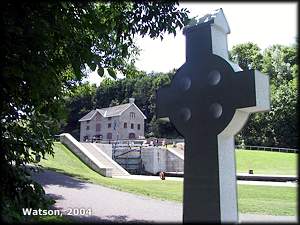
Located on the east side of the lower locks in Ottawa this monument was unveiled on June 27, 2004. It was raised by the Rideau Canal Celtic Cross Committee which was supported by the Irish Society of Ottawa and the Ottawa and District Labour Council.
The memorial reads: "In Memory of 1000 workers & their families who died building this canal 1826 - 1832."
|
Will there be more memorials? Many of the canal construction sites had a graveyard - some are still known, others have been lost to time. So, similar to the work done with the canal era cemeteries at Chaffeys, Newboro and Merrickville, some of these could be restored and memorials raised.
Of the labourers, the French-Canadian component hasn't been memorialized. They lived and worked under the same conditions as the Irish immigrants. Since they have few descendants in this area, there is no one around to remember them. The skilled labour force is another group that hasn't received much recognition for work they did under extremely difficult conditions. Many of them died of malaria which was indiscriminant in who it killed.
Another unsung group are the women, wives of many of the labourers, contractors, skilled workers and Sappers & Miners. Quite a number of these lived at the work sites and records show that many of them and their children died from malaria. The life they led is poorly documented in the historical records and their story has yet to be told. For a brief look at this issue see the article Women at the Rideau Worksites
|